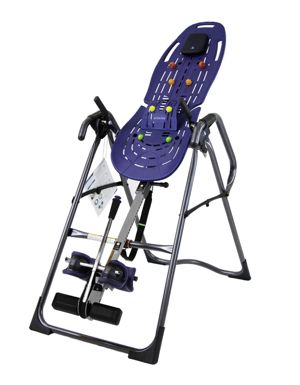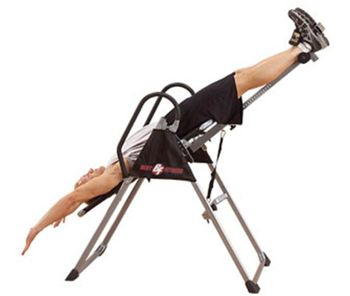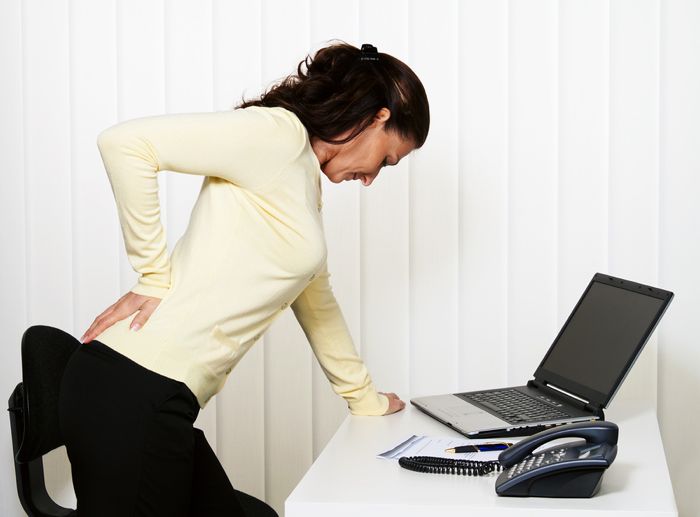If you’ve ever struggled with back pain, you’ve probably heard of inversion therapy.
It’s the idea that inverting the body (upside down) can help treat conditions of the spine, potentially easing back pain, reducing pressure on spinal nerves and discs, and even increasing the space between the vertebrae to promote a healthier spine overall.
The company “Teeter” has become the industry leader in inversion tables (and other inversion products), having been on the market for over 30 years.
I’ve been aware of the “Teeter Hang-Ups” for a long time. As someone who suffered a herniated disc when I was in my thirties, I’ve been on the lookout ever since for alternative treatments that can ease back pain.
Yoga continues to be my number-one go-to when it comes to keeping the spine flexible and in shape for all the sitting that I do while writing. It’s kept me out of the doctor’s office and away from surgery for a lot of years.
A few months ago, though, I suffered a setback. The pain wasn’t as bad as when I suffered my first injury in my thirties, but it was bad enough that I couldn’t sit for more than 20 minutes without suffering serious pain that forced me out of the chair. Standing wasn’t much better.
I had a few important events coming up that I had to be ready for—including a few hours on a small plane (ouch!)—so I had to do something. I’d been reading up on inversion therapy for years, and I figured it was time to put it to the test, so I took the plunge and purchased a Teeter Hang-Up of my own.
With my Writing and Wellness readers in mind, I kept a diary of sorts to track my early experiences with the device, in case any of you may be thinking of trying it.
But first, a bit more about inversion therapy. Does it really work?
Does Inversion Therapy Work?
Inversion therapy isn’t anything new. Hippocrates is reported to have used it to relieve his patients’ ailments. More recent studies have shown the treatment to have a number of benefits, but to be particularly helpful for back pain.
In 1978, for instance, researchers studied inversion in 20 men, and found that it actually lengthened the spine and reduced muscle activity. Researchers theorized that because of these effects, it could relieve back pain and muscle spasms that cause back pain.
As we use the effects of gravity to reverse pressure on the spine, we allow the discs to “breathe” in a way, opening up the spaces where the nerves live, which enables nerve signals to travel more easily to and from the brain, reducing the sensation of pain. Roger Teeter, founder of the company, also asserts that spending time upside down eases stress on the back and neck, decompresses the joints (improving joint health), and relieves sciatica pain.
In 1985, researchers put the therapy to the test again, and found that it increased trunk flexibility (the ability to bend forward), and opened up the spaces between the vertebrae. “These findings establish the physiological basis for the clinical effects of Inverchair Therapy and for its appropriate clinical utilization,” the researchers wrote.
Even more impressive was a 2012 study on patients who were in line for back surgery. Half were sent for physiotherapy and the other half received physiotherapy with inversion. Over three-quarters of those that went through the therapy with inversion ended up not having to go through surgery, compared to only 22 percent of those in the physiotherapy alone group.
“Intermittent traction with an inversion device resulted in a significant reduction in the need for surgery,” the researchers wrote.
“I was surprised to see how effective it was,” added study co-author A. David Mendelow, a professor of neurosurgery at Newcastle University in Newcastle upon Tyne, England.
Potential Risks of Inversion Therapy
Most of the studies so far, however, have been small, and there are some risks. The Mayo Clinic, for example, notes that while inversion can help relieve back pain, it increases pressure in the eyeballs, which isn’t good for people with glaucoma.
If you stay upside down for more than a few minutes, it can increase overall blood pressure—a potential danger for those who already have hypertension, or who have cardiovascular disease. (Though the 1985 study mentioned above failed to find any increases in overall blood pressure.)
There are some other potential dangers. For some people with certain spinal conditions, the therapy could actually make things worse. Those with recent spinal trauma, for instance, may want to wait until they recover to try it. The treatment is also not recommended for those who’ve suffered a stroke, those who have osteoporosis (weak bones), or who may be at risk for a hiatal hernia.
On the other side of the coin, though, the therapy is considered especially beneficial for those with general back pain, muscular pain, herniated discs, spinal stenosis, and degeneration. Because it helps the blood circulate more easily through the upper body, it is also sometimes recommended for recovery from a high-impact workout.
The best approach is always to check with your doctor before trying this or any other similar device.
 The Teeter Arrives—Setup and Operation
The Teeter Arrives—Setup and Operation
Armed with my research on the therapy, I eagerly awaited the arrival of my Teeter. I got one of the more recent models, the EP-970. When it showed up on my doorstep, I was a bit intimidated, unsure if I could get the big, long box inside! I managed to push it up the three stairs and in through the front door, after which I was home free.
I cut the box open and took the parts down to the basement, where I have all my exercise equipment. It took about a half-hour to put together—piece of cake if you follow the directions. Then I watched the DVD that came with it to be sure I had all the settings right.
You adjust the height of the chair, for example, according to your height, but you can always change it, so don’t worry about it too much. I ended up changing it twice in the first few weeks. There are some other parts you can adjust too, but none are a big deal. You can try the device and then make adjustments as you get used to it.
Major precaution: The biggest issue I had was with the part that locks your ankles in place. You place your feet on the pedals, and then close the padded ankle holders around your ankles. My model had the so-called “ratcheting handle” that is easy to reach, but it has a depress button that I had trouble with at first.
Eager to try it out, I stepped into the device and depressed the button and pulled the ratchet toward me to lock in my ankles. Then I spent a little bit of time upside down, but when I came back up I depressed the button and couldn’t get my ankles free.
The ratchet wouldn’t move.
I felt a minor panic as I was alone and my cell phone was out of reach. I could just imagine me calling 9-1-1 asking for someone to come and help me get out of this device! Because once your ankles are in, they’re in—you can’t move. This is good for when you’re hanging upside down. You don’t want to end up falling on your head because the device lets go of your ankles!
But it’s not so good when you’re first learning how to work the device. I finally got the button to depress and release, and got out. I knew I had to be doing something wrong so I checked the instructions again and realized that I needed to pull the ratchet closed without depressing the button, and then depress it to release. After that, I had no more problems.
 My First Day of Inverting
My First Day of Inverting
The first time I inverted, I actually felt some pain in my lower back. That was confusing, for sure. The device was supposed to help! I had to come up slowly as it hurt some upon rising. My spine obviously wasn’t used to this.
I continued to use it, though, for a few minutes every day after my exercise workout. It took me some time to get used to the ankle holders—to learn how to position them so my ankles were comfortable. There are a couple ways you can adjust them, and you can also choose to wear thicker socks. I tried a number of things and finally ended up positioning my feet so the holders came up a bit higher on my ankles, which seemed the most comfortable for me.
My ankles still tend to get a little tingly (numb-like) when I hang upside down for several minutes. I’m still working with the adjustments, but I find that I can hang comfortably for as long as I need to.
I also discovered that the height adjustment was important. If you have it too long, it’s more difficult to get the device to rotate, whereas if you have it too short, you get on and whoosh, over you go! This adjustment also depends on the ankle adjustment, so you will change one as you change the other. The changes are easy to make, so I had no problems playing with this until I got it to the right place.
Weeks One and Two in a Teeter Hang-Up
For the first several weeks, I was playing with adjustments. I was trying different socks and shoes, different heights, and different pedal placements. This was a period of experimentation, so a warning here to readers—it takes some time to figure this thing out. This isn’t something that you hop into and voila, no more back pain. As with any device, you have to get used to it, and fix it so it works for you.
One of the things I noticed initially was that I was rather clumsy in my efforts to rotate. All you have to do to turn upside down is raise your arms over your head and lean back. Coming back up, however, is a little different. I was doing it wrong initially—I was bending from the waist and reaching for the handles to pull myself up. But this required me to put extra strain on the spine to bend and lift after I had just worked to relax it.
After watching the instructions, I realized that I was supposed to bend my knees to come up. I tried it and it felt a little weird at first. It took about a week to get used to it, but now it’s like second nature to rotate upside down and right side up with smooth, easy movements in the legs and arms that don’t put stress on the back.
I highly recommend watching/reading the instructions carefully so you get these movements down right from the start.
I would also recommend that you go slowly. Invert only as far as you feel comfortable, initially. I didn’t go all the way over at first. I just leaned back to about the position one might have while in the dentist’s chair (not a comfortable thought, I know, but you get the idea). I couldn’t get hold of the bar on the floor that allows you to pull yourself all the way over until I’d been doing it for awhile.
Me and My Teeter Today
Within a few days I could invert without pain in my back. Within a few weeks, I had mastered all this—the movements, the adjustments, and the inverting all the way.
Today? I am addicted to my Teeter. I use it every day after my workout, and my body looks forward to it like it might a massage or a hot bath. It feels soooooooo good. I strap my ankles in, lie back, and spend a minute or so partially inverted to let my body adapt, and then I go all the way over and just close my eyes and relax.
My spine thanks me every day. I’ve also noticed some relief of knee pain, and I definitely feel it helps in post-workout recovery.
Bottom line—does it work for back pain? It sure has for me. A lot. I fully recovered from my set back and any time I feel a twinge, a couple trips on the teeter sets me right as rain. It doesn’t mean I can abuse my spine with hours in the chair and be fine, but it does mean that I can recover faster, and that I feel stronger on the whole. I was traveling for a couple weeks and really missed it while I was gone. I hit it the first day I was home, and felt like myself again.
I’d highly recommend the device for anyone struggling with back pain. Do check with your doctor, and be aware of the potential risks. Buy from a retailer who will allow you to return the device if you’re not happy. (I used HSN—they allow returns and the flex-payments without interest were very helpful.)
There’s no reason for you to continue to suffer, however, if something like this can help. We know how difficult it can be to find solutions that offer true relief. This isn’t a cure by any means, but it’s a very helpful tool to add to your arsenal, and it may just help you live a more comfortable life.
And that’s definitely worth the investment.
Have you tried inversion therapy for back pain?
Sources
Nosse LJ, “Inverted spinal traction,” Arch Phys Med Rehabili., August 1978; 5(8):367-70, http://www.ncbi.nlm.nih.gov/pubmed/687049.
Howard Vernon, et al. “Inversion therapy: a study of physiological effects,” J Can Chiropr Assoc., September 1985; 29(3):135-140, http://www.ncbi.nlm.nih.gov/pmc/articles/PMC2484360/.
Prasad KS, et al., “Inversion therapy in patients with pure single level lumbar discogenic disease: a pilot randomized trial,” Disabil Rehabil., 2012; 34(17):1473-80, http://www.ncbi.nlm.nih.gov/pubmed/22263648.
Laura Johannes, “Benefits of Hanging Upside Down,” Wall Street Journal, June 2, 2014, http://www.wsj.com/articles/benefits-of-hanging-upside-down-1401747480.


Okay, now THIS got my attention! As with most writers, I too spend so much of my day in front of a computer. Add to that all the years of wear and tear and . . . well, yep, back pain.
I’m so excited this works for you! I am gonna give it a try. Wish me luck!
Good luck, Susan! Took me awhile to get the hang of it, but now I love it. Hope it helps you, too. :O)